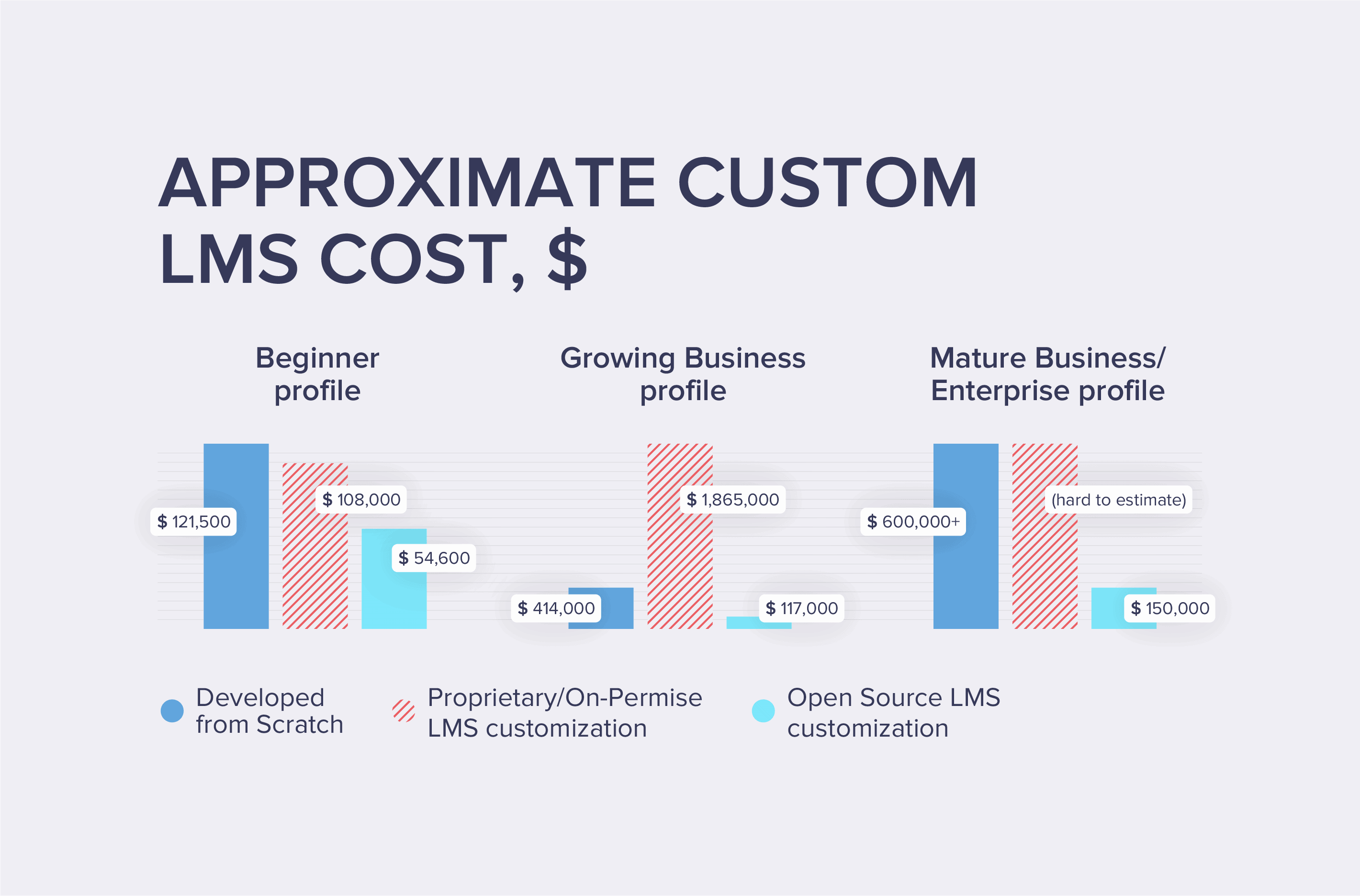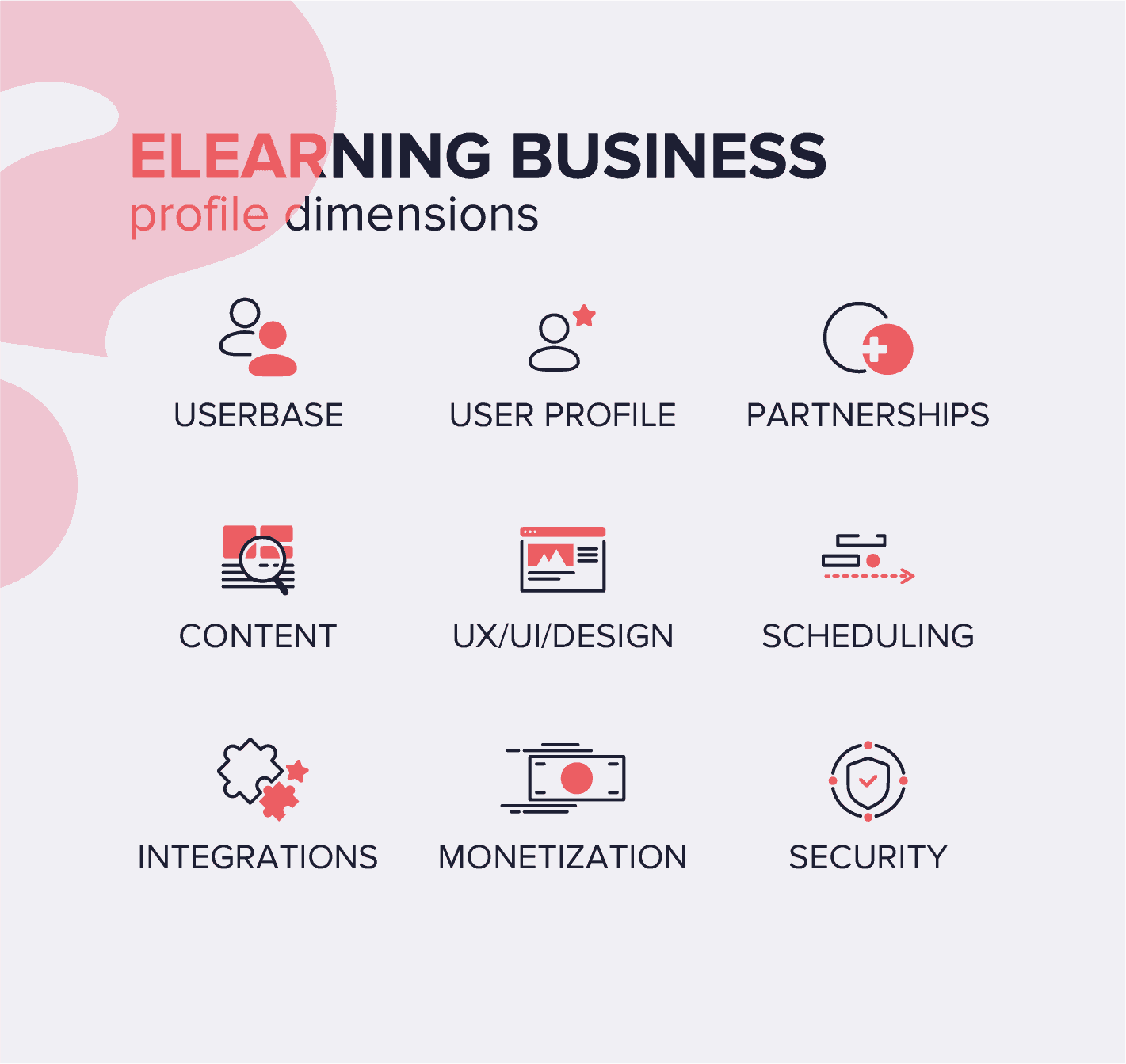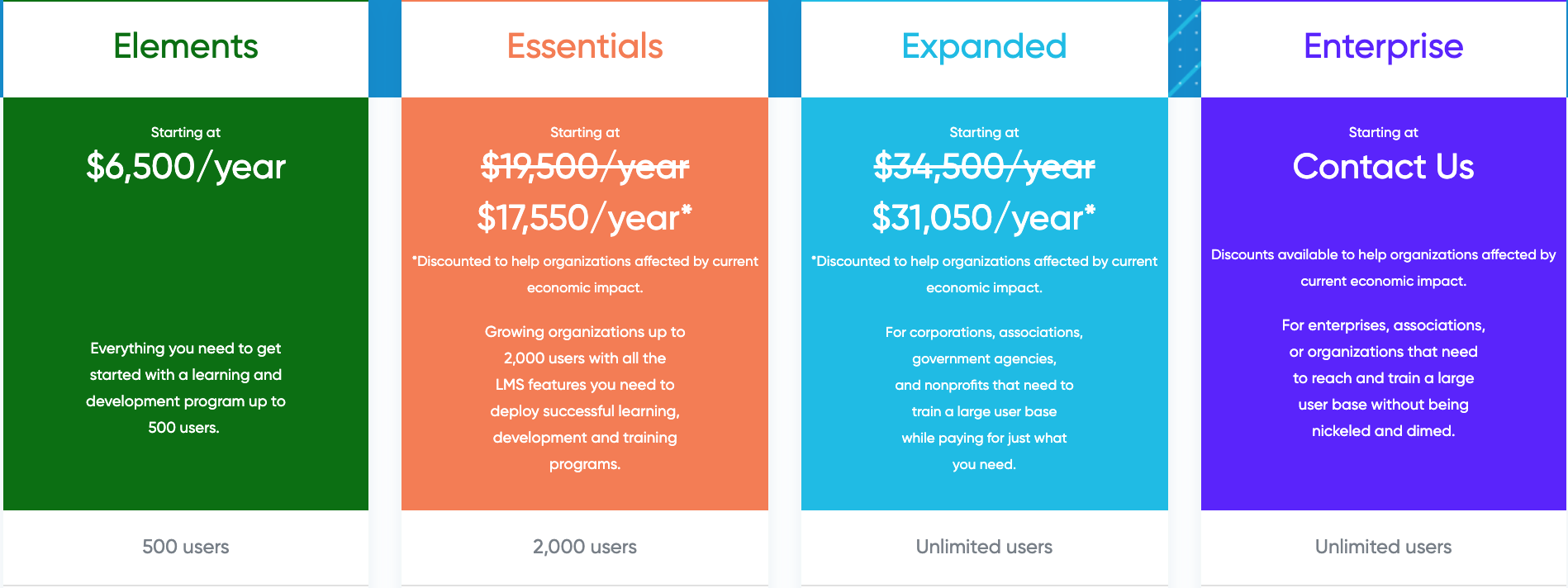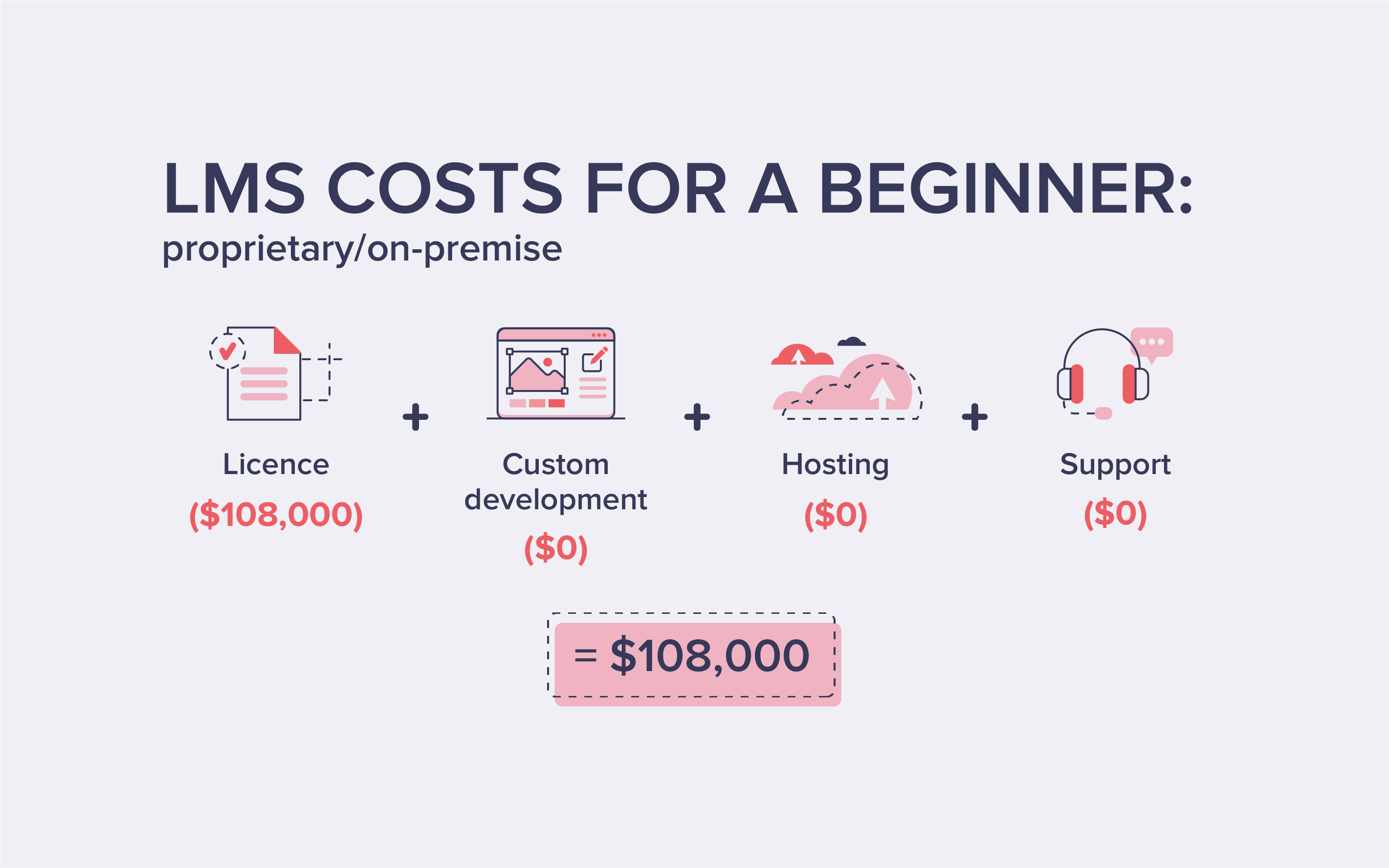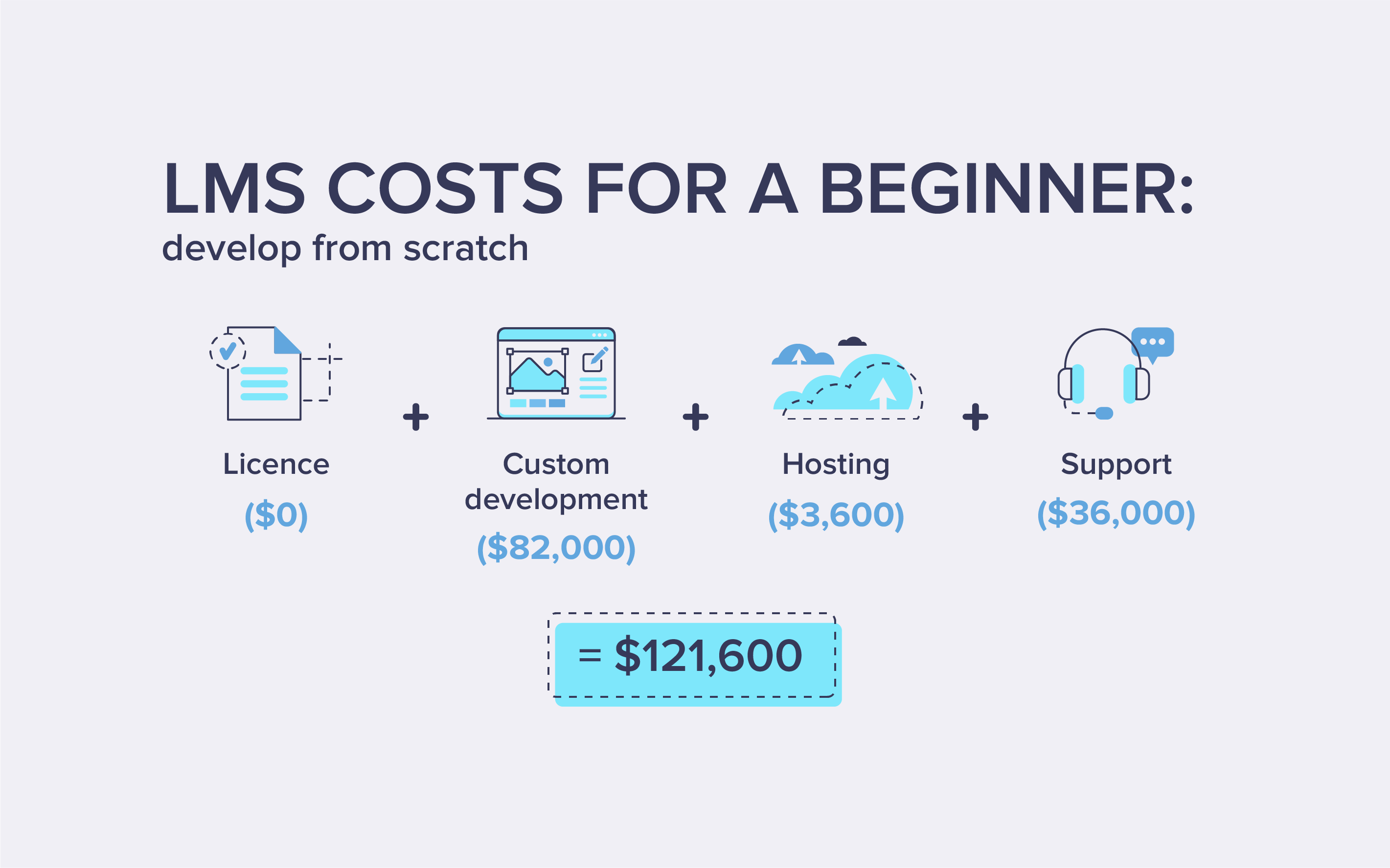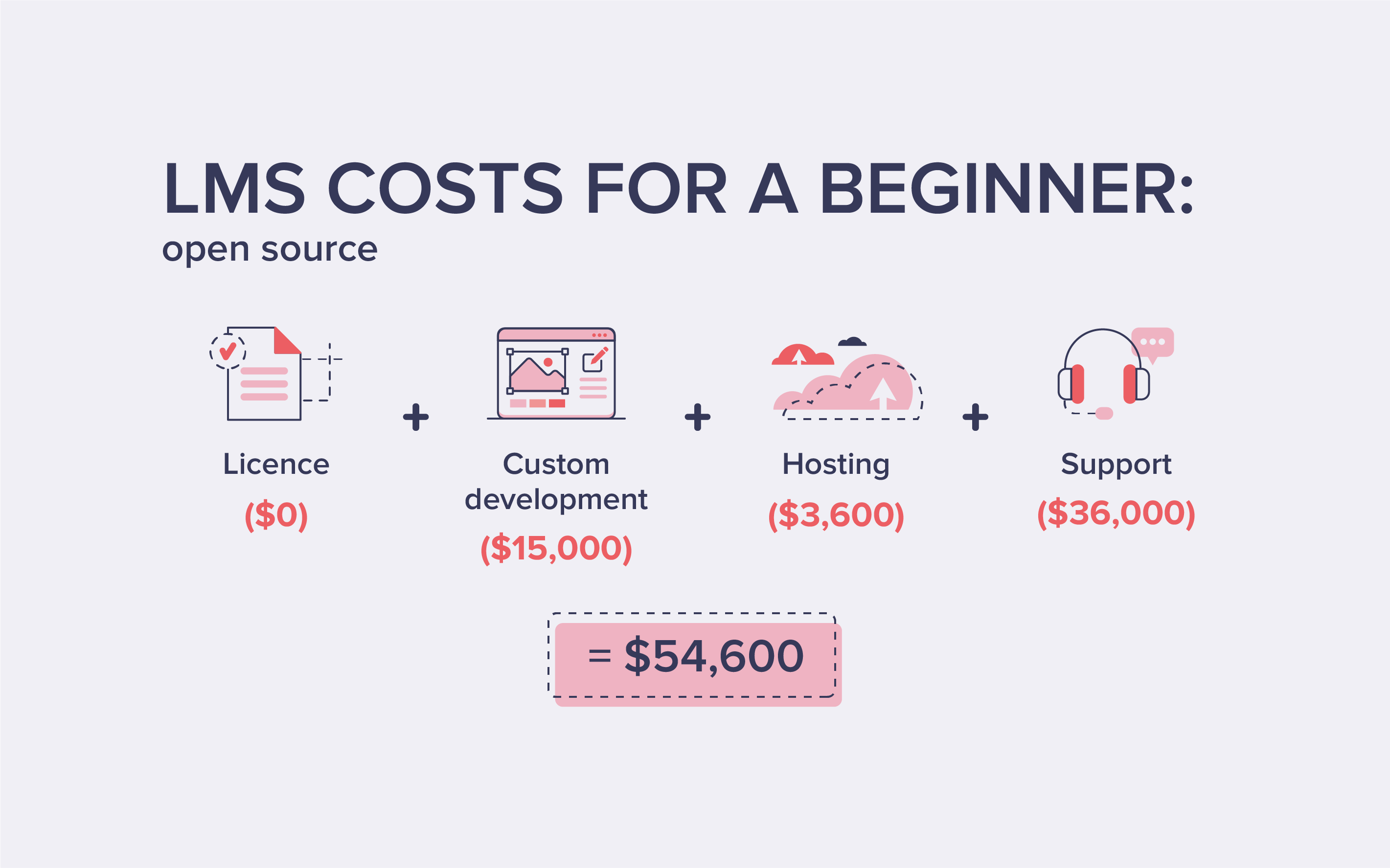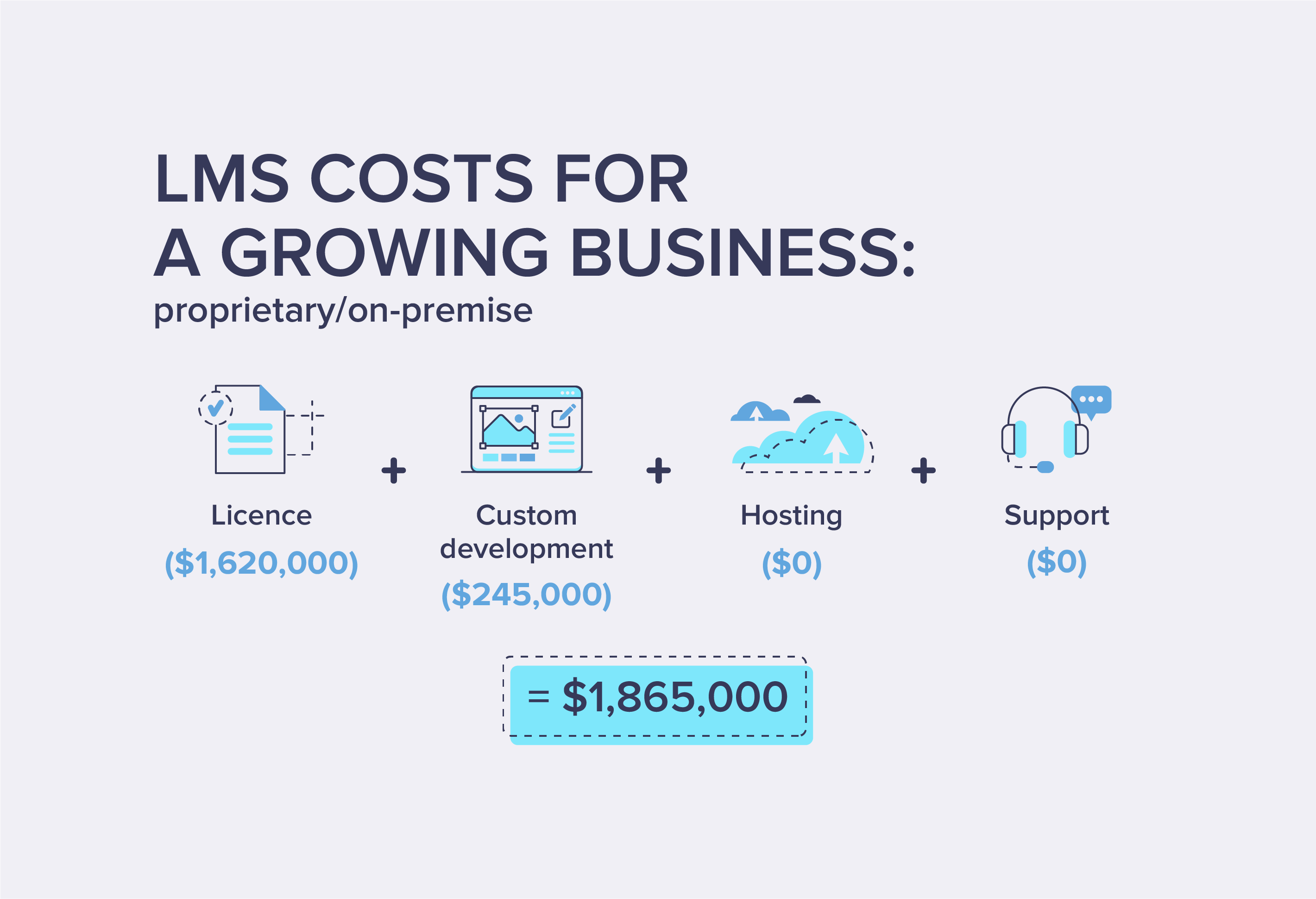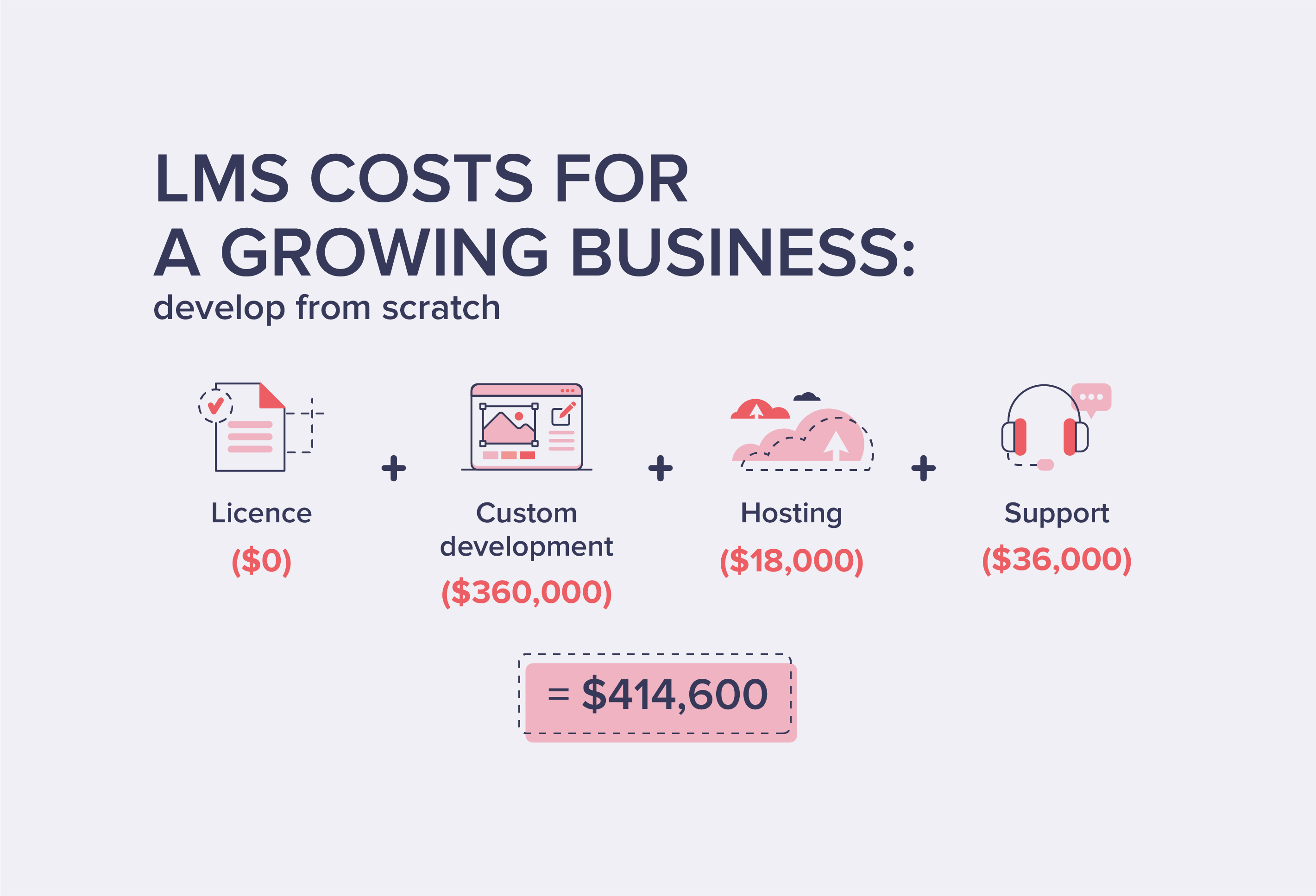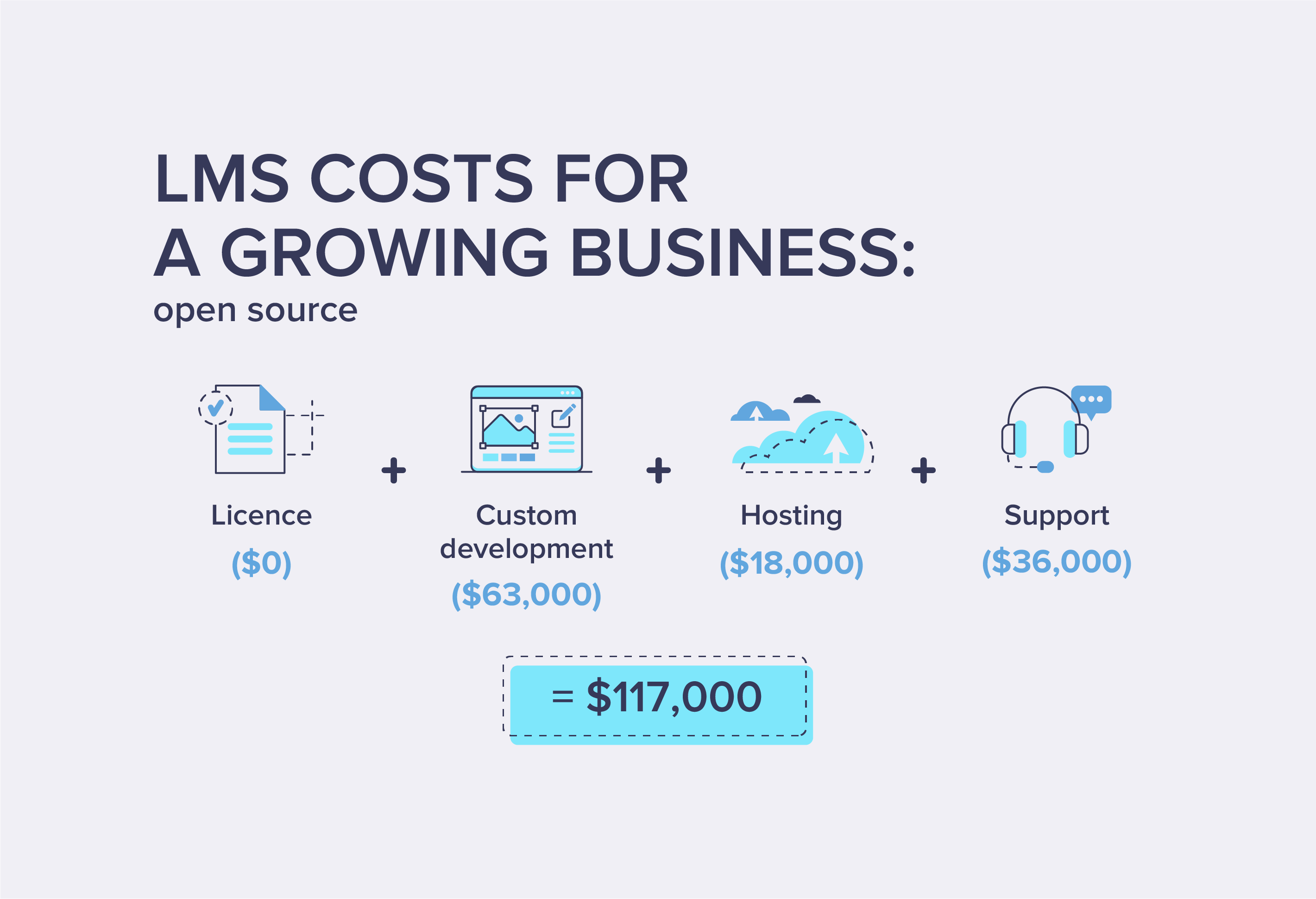LMS pricing varies widely and is influenced by features, integrations, support, and scalability, so align priorities before budgeting. If you’re wondering how much an LMS costs, remember that the price changes with scope and scale. We’ll discuss Learning Management System pricing factors as we go.
In the LMS world, there is no one-size-fits-all solution, as in any other software. That’s why there are so many solutions available: content creation platforms like Adobe Captivate and Articulate Storyline position themselves as “all-in-one,” there are tons of SaaS solutions, on-premise solutions, built-in solutions in ERPs, CRMs, HR management systems, and open source technologies. When comparing learning management system pricing, these models differ significantly in terms of budget and control. Organizations begin considering custom LMS development when off-the-shelf solutions fail to meet their needs. Dissatisfaction may stem from design, UX/UI, mobile app capabilities, skill management, integration options, and automation features. Customization desires extend to embedding content, tailoring certificates (partner badges, language, autocomplete fields), and adjusting the learning path with course sequences, prerequisites, and roadmap visualization.
Additionally, specific needs arise in enrollment logic, reporting, gamification, mobile app functionalities, and access management. As we said in our promo video, “Your business is unique, your customers are unique, so your LMS should be unique too.” That is where the learning management system cost becomes a strategic question, not only a number.
If someone has all the money in the world, the best choice for them would be a custom LMS. But learning management system pricing might reach a fortune, right? Not necessary. You can have a highly customized learning management system for a reasonable cost. Let’s start by defining the typical profiles, as they are the key to determining the budget you should prepare.
Key takeaways:
-
The costs of custom learning management systems can vary greatly. It usually depends on your type of business (LMS prices for beginners and enterprises can’t be the same) and the functionality you’d like to have in your LMS.
-
One of the most cost-effective options for growing businesses (and not only them) is open-source LMS customization, which is up to 16 times more affordable than other ways of building a custom LMS.
-
Always consider additional costs such as setup fees, training and support, integrations, and content when calculating learning management system cost, unless your service provider includes them in the original price (as Raccoon Gang does).
What Type of Business Are You?
From our experience, you most probably belong to one of the following profiles. We’ll describe each profile briefly from the perspective of several key dimensions:
- Userbase: how many users/learners a company expects to serve monthly in the next 12 months
- User profile: who are the learners
- Partnerships
- Content: what types of content an organization plans to use on the platform
- UX/UI Design: how important it is for an organization to create a unique interface, dashboards, custom designs for roadmaps, course catalogs, etc.
- Scheduling: level of sophistication of course enrollment, course pacing, and course completion mechanics. For example, learners can experience simplified scheduling through self-paced courses that are fully open after enrollment. Sophisticated scheduling provides automated enrollments depending on skill assessments, recommendations, customized and personalized content delivery, skill-based sequences, online schedules synchronized with offline schedules, etc.
- Integrations: what is the expected level of complexity of integrations between the learning platform and other systems (marketing, CRM, ERP, etc.)
- Monetization: level of complexity of monetization mechanics
- Security: compliance, access, governance, policies and their reflection in software: automation, rules, scenarios
Cost Ranges for Custom LMS Solutions
| Profile description | Beginner | VIP Club | Growing Business | Mature Business and Enterprise |
| Userbase | <1K/month | <1K/month | 1K-20K/month | 20K-100K users/month |
| Users | Individual learners, self educators | Executives, founders, investors, producers, etc | Corporate sector/self educators combo | Custom and individual |
| Partnerships | Little to no partnerships |
Partnerships with universities, business schools, etc.
|
Universities, business schools, content delivery services, etc. | Custom and individual |
| Content | Images, slides, PDF, video files (upload or link) | Classic content + custom assessments + interactive group tasks + external publishers | Often custom content and custom experiences are added to the equation | Custom and individual |
| Design | Simple branding and standard user interfaces are understandable by any user | Unique, classy, and subject-specific; personalized dashboards, roadmaps, etc. | Branding is very important: custom UX/UI is a must | Custom and individual |
| Scheduling | No interdependent sequences, or skill-based roadmaps; no prerequisites or enrollment automation | Roadmaps, sequences, automation, and 1to1/group lessons need to be automated | Sequences, skill-based learning, custom course enrollment mechanics, custom course pacing. Custom certification; custom recommendations | Custom and individual |
| Integrations | Social login, email plugins, etc. | Content publishers, referral databases, CRM, etc. | Automation and API connections, deep integrations | Custom and individual |
| Monetization | Free courses; simple subscriptions/packages | Partnerships, networks, subscription packages, statuses, etc. | Subscription levels, partnerships, discounts, giveaways, packages, customer segments | Custom and individual |
| Security | Basic security: no multi-level hierarchy for approvals management | High-security standards; low level of bureaucracy | High-security standards; high level of bureaucracy on the customer’s side | Custom and individual |
Beginner
Profile description
Userbase: <1,000/month
Users: individual learners, self-educators.
Partnerships: no partners from a content or certification perspective.
Content: images, slides, PDFs, video files (uploaded directly to the server or YouTube).
Design: simple branding and standard user interfaces understandable by any user but no big ambitions from the design perspective.
Scheduling: simple – individual courses with no interdependent sequences, or skill-based roadmaps. No prerequisites or enrollment automation.
Integrations: simple integrations like social login, email plugins, etc.
Monetization: free courses; simple subscriptions/packages.
Security: basic security is enough, there is no multi-level hierarchy for approvals management or strict compliance rules that provide for complex access management and approval processes.
Need for a custom LMS
For such a profile, many SaaS options exist, and native admin settings enable some customizations. There is no particular need to develop a custom LMS.
VIP Club
Profile description
Userbase: <1,000/month
Users: executives, founders, investors, producers, etc.
Partnerships: numerous partnerships with universities and business schools from both content and certification perspectives.
Content: can be mostly classic types of content like videos and slides, with specific custom assessments/exams and interactive group tasks; integrations for connecting content from external publishers might be needed.
Design: design, in most cases, needs to be unique, classy, and subject-specific; personalized dashboards, roadmaps, and other elements are needed to engage the audience.
Scheduling: roadmaps, sequences, automation, and 1-to-1/group lessons need to be automated and perfectly arranged.
Integrations: integrations with content publishers, referral databases, CRM, and other systems are mostly needed.
Monetization: usually complex monetization via partnerships, networks, subscription packages, statuses, etc.
Security: high-security standards, but often not a lot of bureaucracy.
Need for a custom LMS
In this case, custom LMS is vital as there is a need to deliver a unique learning experience and support branding with a unique platform design: basic customization options provided by a packaged solution won’t be enough.
Plus, integrations with CRM and partner network systems, organization of seamless logins, and numerous automation to make the service seamless and user-friendly will require custom development. Since this is a luxury segment, you shouldn’t even be worried about custom LMS cost, as it is sure to earn itself back.
Growing Business
Profile description
Userbase: 1,000-20,000/month.
Users: often a combination of the corporate sector and self-educators.
Partnerships: selling knowledge to organizations requires partnerships; sometimes partnerships with learning content providers.
Content: can be simple or sophisticated from project to project. Often custom content and custom experiences are added to the equation.
Design: custom design is almost always a must: basic customizations like changing the logo, color theme, and sequence of info blocks are not enough. Branding is too important for this segment.
Scheduling: sequences, usage of paywalls, skill-based learning, custom course enrollment mechanics, and different course pacing for different types of clients. For custom certificates, automated certificate templates are often needed. Advanced and customizable course recommendations are also “top sellers.”
Integrations: for this segment, integration with clients’ systems and software is often needed; in many cases, numerous automation and API connections are needed to automate business processes, save time and money on routine, and build seamless client experiences.
Monetization: subscriptions of different levels, partnership programs, discounts, giveaways, packages, differentiation by customer segment – all the modern mechanics are necessary for this segment to grow further.
Security: high security standards and a growing level of bureaucracy along with the high level of bureaucracy on the customer’s side require sophisticated security mechanics to be in place.
Need for a custom LMS
Growing businesses definitely need a custom LMS. It’s one of their main growth drivers, customer retention factors, and ROI optimization levers.
Mature Business and Enterprise
Mature business: 20,000-100,000 users/month
Enterprise: 100,000+ users/month
Mature businesses need a custom LMS and even more, they mostly become mature because of custom LMS introduction in their earlier development stages. In our experience, 95%+ of mature businesses already have a legacy custom LMS and are looking for modernizations, innovations, migrations, and so on.
Overall, 99%+ of enterprises have their own custom learning management systems. The issues they are resolving and innovations they are looking for are connected with AI/ML, Blockchain, Cloud Computing, and so on. Many of them are struggling because of non-future-proof technology choices. Their legacy technologies are blocking them from moving forward quickly. Why are we talking about it in this article? You’ll get to know it soon.
Popular Pricing Models for LMS
When considering how much an LMS costs, understanding the different pricing models is crucial. Let’s delve into the main LMS system pricing models.
Model #1: Pay Per Learner
This model operates on a straightforward principle: the LMS price is determined by the number of students or active users it serves. Different packages are typically offered based on student numbers, allowing for easy prediction of monthly costs.
An example of this model is Adobe Captivate Prime, which charges $4 per month for each registered user.
Model #2: Pay as You Go
This model offers flexibility, with costs based on platform usage. Payments fluctuate depending on workload, meaning lower fees during low-activity periods and higher fees during peak times.
Model #3: License Fee or Subscription
Many platforms offer fixed-price plans with varying features. Topyx LMS, for instance, offers different plans with distinct features and pricing, allowing organizations to choose a package that best suits their needs and budget. This model is common in SaaS LMS pricing structures, offering predictable costs with a range of features.
Model #4: Free to Use
Open-source LMS platforms are free but may require customization. This is an excellent choice for those who want maximum platform flexibility or have specific learning processes, and none of the other LMS platforms can cover them. While basic configurations are costless, customization often involves professional development support.
Custom LMS cost
If you are a VIP club, growing business, mature business, and especially enterprise, you’ll need a custom LMS. Now, what are the ways to create your unique custom LMS that your competitors’ sales reps will start to use as an excuse for their sales decrease? Let’s outline different ways and the average cost of learning management systems. We will consider the following ways to build a custom LMS:
- Proprietary/on-premise LMS. Those are packaged solutions that are proposed in a SaaS or hosted form that offers APIs, with simple customizations that are managed using built-in tools. Most popular brands allow customization options via their network of certified software development partners.
- Building LMS from scratch. There are a lot of software development providers that offer their custom LMS development services with an unlimited feature set.
- Using open-source technology. Open-source technology gives you some basic and sometimes even advanced features for free, and you can customize it into almost anything that you want by choosing development companies that specialize in that technology. We’ll use the Open edX LMS as an example as we have a lot of experience with it and we believe that it is a truly disruptive and forward-thinking technology.
We’ll stick to estimating the cost of a learning management system that will be accumulated in the first 3 years so the hosting and licensing payments are taken into account.
Custom LMS costs for a Beginner
Beginners will need a basic set of features from all perspectives, as we discussed. The list of features is described in a lot of blogs and e-learning publications, and they are fairly straightforward:
- LMS learner portal, where users can find courses and enroll.
- Learner’s space where one can consume courses, join online lessons, be engaged in discussions, pass assessments and exams, and get certificates; sometimes there are even basic badging features; mobile apps are often considered essential.
- Basic admin panel where platform managers can create courses, manage enrollments, and have access to generic reporting.
Custom LMS costs for a Beginner: proprietary/on-premise
You won’t need to pay for hosting and any development because all the features described above are available in most SaaS or On-Premise LMS providers. You’ll just need to pay for a license per registered (important: NOT active) user. So when there are around 1,000 active users, there are usually at least 1,500 registered users.
The average LMS price per registered user for such a scale is around $2/month. So, in 36 months the total bill is going to be $108,000. The open edX hosting and the support are usually included in the package.
Custom LMS costs for a Beginner: develop from scratch
Of course, the majority of e-learning businesses/organizations that are in the Beginner stage would not start to develop LMS from scratch because they don’t start with something around 1,000 monthly users, they start small (SaaS, self-hosted open-source LMS) and build up while they grow. However, we need to estimate a basic LMS developed from scratch because it will help us to build up the custom LMS cost for other levels.
As many software development companies already created their blog posts on the LMS development cost, we can use that information as they describe the cost exactly for something fairly basic.
The price for a basic LMS that would fit our Beginner segment varies from $25,000 to $90,000. Let’s take the average: $57,000. This average cost of the learning management system resonates with our experience and sounds like a meaningful one. We’ll also need to add mobile applications which are essential nowadays. Those would add around $25,000.
Let’s also include hosting expenses. Monthly hosting fees for the considered number of users (NOT registered) would be around $100 per month, which in 3 years makes up around $3,600.
Support also might be needed and it would make up around $1,000 per month → $36,000 in 3 years.
❗️Another important note here: the choice of technology for development is a dilemma. If you want to save money at the start, you’ll go for some “low cost” technology, where developers have lower rates and the development itself is done faster. But that would turn out to be a problem in the future when you start to grow.
When you grow, you’ll need scalability to keep the system up and running for thousands of active users each second. You’ll need to start leveraging big data, and those technologies might not be a good fit anymore. You’ll be in a position where you need refactoring, migrations, etc. which means a lot of money. Let’s keep that in mind when we move to the next option of which we are the evangelists.
Custom LMS cost for a Beginner: open source
Open source gives you much more functionality than a Beginner would need right out of the box. Take a look at our blog post about what Open edX, the most prominent open-source LMS technology that was developed by Harvard and MIT, can do with no additional customization.
The cost of Open edX implementation, along with the mobile application, reporting tool, and even advanced gamification tool is going to be about $15,000. The functionality that you are about to get is much closer to what a Growing Business would need, at a significantly lower cost compared to other options.
❗️Why? Where’s the catch? There is no catch. This is possible because the edX platform, the result of huge work done by developers led by Harvard University and MIT, one of the biggest online course platforms in the world (acquired by 2U and now part of the biggest player), has been partly shared with the whole world in a form of an open-source platform that has been called Open edX.
You can compare it to Tesla which shared their electro vehicle technologies with the whole world which has changed the automotive market. Now, electric vehicles cost much less than they did 10 years ago. The same happens with custom learning management systems thanks to Harvard, MIT, and their Open edX technology.
To the basic implementation mentioned above, you’d need to add the support package and hosting which is similar to the “develop from scratch” option: $1,000/month and $100/month respectively.
Custom LMS Costs for a Growing Business
Growing Businesses, as mentioned above, will need a lot of customizations to become Mature Businesses or Enterprises. They’ll need to rethink the UX/UI and all the interfaces, add more dashboards and more features, implement advanced reporting and automation, enhance mobile applications, and introduce more platforms in the infrastructure (CRM, HRM, ERP, various marketing platforms, content delivery platforms, etc.) and seamlessly integrate them with the LMS.
Moreover, they will have to build workflows and reports related to them, introduce custom content and custom enrollment workflows… in other words, build up the infrastructure.
❗️Additionally, the question of scalability starts to arise. It is a crucial question because not all technologies and platforms will be able to guarantee decent uptime and stability with 1,000+ consecutive user loads.
A cost comparison reveals the real difference here. Let’s consider that we are a Growing Business and need to build an appropriate LMS with the whole infrastructure without being a Beginner. So, the first 3 years, again. We are aiming for 20,000 active users per month.
LMS costs for a Growing Business: proprietary/on-premise
You would still need to pay per registered (NOT active) user, so if there are 20,000 active users, there are usually at least 30,000 registered ones. With such a scale, providers would charge around $1.5 per user per month. So, the whole cost for the base software for 3 years would be around $1,620,000. Now, let’s add customizations.
As you are “vendor-locked,” you need to hire vendor-certified developers to be sure about the quality, and their price is going to be significantly higher than the market average for a given technology. It’ll cost you an average of $175/hour.
The customizations that we’ve outlined as needed for a Growing Business would take 800 to 2,000 hours of development time, as such platforms are made to be customization-friendly (yet this is quite expensive). Let’s consider an average of 1400 hours, which is equal to $245,000.
Custom LMS costs for a Growing Business: develop from scratch
If you develop everything from scratch (not upscaling from a Beginner phase), you must go through a huge phase of documentation creation, business analysis, and architecture planning to get a good result. However, you can choose the appropriate technology and plan for scaling. Considering all the factors, a fair software development vendor would tell you that with your requirements, you should aim for around 6,000 hours of development.
Qualified and experienced companies will charge you between $40 and $150 per hour depending on the location, so let’s consider a $60 rate (if someone tells you that you can find even a $20 rate – that’s true, but in this case, our estimates should be multiplied by 4X and we should add a 40% risk of a bad result and need for expensive refactoring afterward).
So, the $60 rate means around $360,000 for the development. We again should add around $36,000 for 3-year support and take into account around $500 per month for hosting, considering 20K monthly active users.
When you factor in the cost of creating an online course, these figures illustrate how crucial it is to have a detailed plan and choose the right development partner. The total investment required not only covers the initial development but also ongoing maintenance, support, and hosting, which are essential for ensuring the long-term success and scalability of your online course platform.
Custom LMS costs for a Growing Business: open source
❗️As has been mentioned before, a lot of features suitable even for Enterprises, are already present in Open edX (some other open source LMS technologies are not exclusions) and implemented in the form of pluggable features: programs, eCommerce, prerequisites, user access, gradable SCORM and LTI compatibility, video players, audio players, reporting tools and now even a gamification tool developed by us.
What’s also very important is that Open edX is built on the Python programming language, which is super scalable and AI/ML/Big Data friendly. So, from 60% to 80% of all the needed functionality is covered out of the box. Take a look at the project we delivered that is relevant to Growing Businesses: 70%+ of all the requirements have been covered out of the box.
Considering what’s said above, the average development effort needed to implement a custom LMS based on open source (Open edX in our case) technology for a Growing Business is around 800 hours, plus the packaged solutions that comprise $15,000 (we mentioned it when we were talking about the custom LMS costs for Beginners based on Open edX). The support also remains in place ($1,000/month), along with hosting ($500/month).
❗️Let us offer some references to a couple of our projects that comprised comparable budgets and had scopes even closer to Mature Businesses and Enterprises:
The difference between average expenses and other ways to get a custom LMS is surprisingly big, but that’s the reality. Top organizations worldwide choose open source, particularly Open edX, for their e-learning projects “for a reason.” By the way, Tesla uses Open edX as their LMS technology of choice as well 😉
Custom LMS Costs for a Mature Business and an Enterprise
We will not cover this part in detail as the costs of LMS for a relatively big company can vary significantly. Some enterprises “go simple” and their custom LMS can be evaluated at around $300-400K, while other Mature Businesses aim to be a “huge VIP Club” and their LMS may have cost them a couple of millions of dollars due to super advanced interfaces, thoughtful automation and workflows, usage of AI-based recommendations and so on.
Hidden Costs to Watch For
When shopping for a custom LMS, it’s easy to get caught up in the initial price. But just like buying a car, the initial cost is just one piece of the puzzle. Several hidden expenses can add up over time. Let’s break down some of the most common ones:
1. Setup fees
Setting up a custom LMS isn’t just about flipping a switch. Think of the setup fee as the “down payment” for your LMS. These fees are usually a one-time cost, but they can vary depending on how complex your system is and what specific features you need.
2. Training and support
No matter how user-friendly an LMS is, you’ll still need some training to get the most out of it. Your team will benefit from learning how to manage the system and use all the features effectively. Plus, having ongoing support is a must when you run into issues or need to make updates. Some providers include this, while others charge extra.
3. Customization
Want your LMS to look and feel like your brand? That’s customization. Whether it’s creating custom courses, setting up special assessments, or designing user interfaces that align with your brand, these extra touches take time and resources, which can impact your budget.
4. Integrations
If your LMS needs to connect with other systems—like HR tools, CRM software, or e-commerce platforms—there might be extra costs involved. These integrations help everything work smoothly together, ensuring data flows seamlessly between systems, but they often require custom development and maintenance, which can add to your overall costs.
5. Analytics
While basic reporting features are usually included, more detailed analytics might come at an extra cost. Investing in these tools can be worth it, though, as they provide valuable insights that can help you improve your learning outcomes and drive business results.
When calculating the cost of a custom LMS, it’s important to consider additional expenses to avoid any surprises later. At Raccoon Gang, we believe in transparency, and we don’t have any hidden fees. We want you to have a clear understanding of all costs upfront so you can make the best decision for your organization and your budget. What you see is what you get.
LMS Pricing Comparison
So, you’ve decided to invest in a Learning Management System for your organization. But with so many options on the market, how do you know which one is right for you? LMS cost comparison is one of the most important factors. In this section, we’ll dive into the LMS pricing structures of different providers and help you understand what you’re getting for your money. Let’s get started!
|
Appx Custom LMS cost, $
(for the first 3 years) |
Type of eLearning Business | ||
| Beginner | Growing Business | Mature Business/Enterprise | |
| Developed from Scratch | 121,500 | 414,000 | 600,000+ |
| Proprietary/On-Premise LMS customization | 108,000 | 1,865,000 | (hard to estimate) |
| Open Source LMS customization | 54,600 | 117,000 | 150,000+ |
We’re confident in our LMS pricing comparison for a few key reasons:
- We have extensive experience in e-learning technology.
- We actively engage with the LMS development community and discuss challenges with decision-makers in organizations considering custom learning management systems. We’ve encountered numerous issues, some requiring significant development time.
- We’ve completed hundreds of projects and estimated thousands more, dealing with various scales and complexities worldwide.
- We firmly believe that for Growing or Mature e-learning Businesses, using Open edX technology can greatly impact prices and outcomes in custom LMS development, as demonstrated by our project descriptions.
This difference is straightforward: leveraging sophisticated solutions already developed and shared with the world can be advantageous when partnered with someone who understands them.
Conclusion
Whether you’re opting for a beginner package or investing in a fully customized solution, it’s important to weigh the upfront costs against the long-term benefits. Remember, the true value of an LMS lies in how well it meets your organization’s needs and helps you achieve your learning and development goals.
At the end of the day, choosing the right LMS is about finding the perfect balance between functionality, support, and the cost of a learning management system. With careful planning and a clear understanding of the expenses involved, you can select an LMS that not only fits your budget but also drives meaningful outcomes for your organization.
We know how Open edX works, we have a lot of experience in custom LMS development, and we have a great Open edX developers team behind us to get it done. So, we can safely say that custom LMS is easy with us.
FAQ
How much does a custom LMS cost?
What factors influence the cost of custom LMS development?
Key cost drivers include:
– UI/UX design and branding
– Backend and frontend development
– Third-party integrations (e.g., CRM, video conferencing)
– Content migration and setup
– Hosting, maintenance, and support
The more features and customizations you need, the higher the cost.
Are there hidden costs when building a custom LMS?
Yes. Common hidden costs include:
– Implementation and onboarding fees
– Data migration from previous systems
– White-labeling and accessibility compliance
– Ongoing support, updates, and cloud hosting fees
Understanding these costs upfront helps avoid budget overruns.

